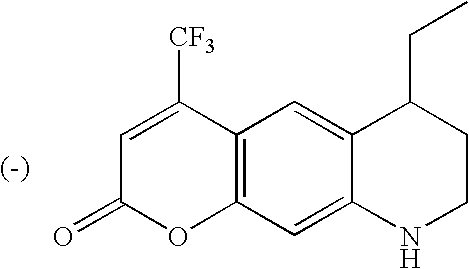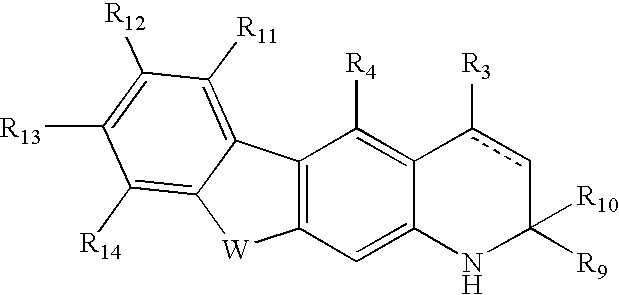Androgen receptor modulators and methods of use thereof
a technology of androgen receptors and modulators, which is applied in the field of androgen receptor modulators, can solve the problems of increasing the risk of falls and especially hip fractures, and reducing bone mass, and reducing the risk of muscle mass and muscle strength. , the clinical use of androgen agonists or antagonists is limited, and the effect of increasing bone resorption
- Summary
- Abstract
- Description
- Claims
- Application Information
AI Technical Summary
Problems solved by technology
Method used
Image
Examples
example 1
4-(Trifluoromethyl)-7,8,9,10-tetrahydrochromeno[7,6-b]azepin-2(6H)-one (1-5)
[0648][0649]Step 1: 7-Methoxy-3,4-dihydronaphthalen-1(2H)-one oxime (1-2)
[0650]To a solution of 7-methoxy-1-tetralone 1-1 (7.0 g, 40 mmol) in EtOH (150 mL) were added hydroxylamine hydrochloride (5.52 g, 80 mmol), and AMBERLYST A-21 ion-exchange resin (8.5 g). The mixture was stirred for 24 h. The resin was removed by filtration and the filtrate concentrated. The residue was diluted with diethyl ether and washed with brine. The organic solution was dried over MgSO4, filtered and concentrated to give the desired product. Data for 1-2: 1HNMR (500 MHz, CD3OD) δ 7.43 (d, J=2.7 Hz, 1H), 7.08 (d, J=8.5 Hz, 1H), 6.88 (dd, J=8.5, 2.7 Hz, 1H), 3.78 (s, 3H), 2.78 (m, 2H), 2.69 (m, 2H), 1.83 (m, 2H) ppm.[0651]Step 2: 8-Methoxy-2,3,4,5-tetrahydro-1H-1-benzazepine (1-3)
[0652]A cooled (0° C.) solution of oxime 1-2 (0.78 g, 4.0 mmol) in THF (100 mL) was treated with DIBAL (20.0 mmol, 1M in 1HF) via dropwise addition. The r...
example 2
4-(Trifluoromethyl)-1,6,7,8,9,10-hexahydro-2H-azepino[3,2-g]quinolin-2-one (2-5)
[0657][0658]Step 1: 2,3,4,5-Tetrahydro-1H-1-benzazepin-8-amine (2-4)
[0659]To a solution of 7-nitro-1-tetralone 2-1 (5.0 g, 26 mmol) in 100 mL ethanol was added tin (II) chloride (14.9 g, 78.5 mmol). The mixture changed from colorless to a deep red. The reaction was heated to reflux and allowed to stir for 2 h under N2. The reaction was cooled, and concentrated in vacuo. The remaining residue was dissolved in EtOAc and washed with 1N NaOH which generated a thick white precipitate. The organic layer was washed with water (2×200 mL), and brine. The organic solution was dried over K2CO3, filtered and concentrated to yield 1.2 g of the amino-tetralone 2-2. A solution of tetralone 2-2 (1.2 g, 7.44 mmol) in EtOH (150 mL) was treated with hydroxylamine hydrochloride (14.9 mmol), and AMBERLYST A-21 ion-exchange resin (5 g). The mixture was allowed to stir until starting material was completely consumed (24 h). Th...
example 3
1,6,7,8,9,10-Hexahydro-2H-azepino[3,2-g]quinolin-2-one (3-1)
[0662]
[0663]A solution of 2,3,4,5-tetrahydro-1H-1-benzazapin-8-amine (0.6 g, 3.4 mmol) and 3-ethoxyacryloyl chloride (0.45 g, 3.4 mmol) in CH2Cl2 (50 mL) and 3N NaOH (10 mL) was stirred for 1 h at ambient temperature. The reaction was partitioned between CH2Cl2 and water. The organic layer was concentrated and the remaining brown oil was dissolved in 70% aq. H2SO4 (20 mL) and heated gently (50° C.) for 2 h. The reaction was cooled and neutralized with aq. NH4OH and partitioned between water and EtOAc. The organic layer was washed with brine, dried over MgSO4, filtered and concentrated. The residue was dissolved in DMF (1 mL) and purified on a GILSON automated system affixed with a YMC COMBIFLASH 50 mm×20 mm reverse phase column eluted 5–95% CH3CN in water at 30 mL / min over 10.5 min to provide pure desired product. HRMS m / z (M+1) calcd 215.1179; found 215.1186.
PUM
| Property | Measurement | Unit |
|---|---|---|
| Volume | aaaaa | aaaaa |
| Volume | aaaaa | aaaaa |
| Mass | aaaaa | aaaaa |
Abstract
Description
Claims
Application Information
 Login to View More
Login to View More - R&D
- Intellectual Property
- Life Sciences
- Materials
- Tech Scout
- Unparalleled Data Quality
- Higher Quality Content
- 60% Fewer Hallucinations
Browse by: Latest US Patents, China's latest patents, Technical Efficacy Thesaurus, Application Domain, Technology Topic, Popular Technical Reports.
© 2025 PatSnap. All rights reserved.Legal|Privacy policy|Modern Slavery Act Transparency Statement|Sitemap|About US| Contact US: help@patsnap.com



